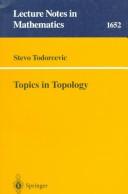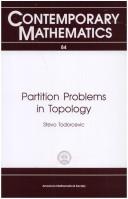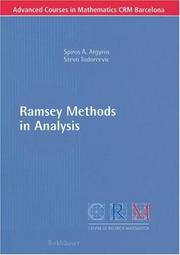| Listing 1 - 10 of 15 | << page >> |
Sort by
|

ISBN: 3540626115 3540683380 9783540626114 Year: 1997 Volume: 1652 Publisher: Berlin: Springer,
Abstract | Keywords | Export | Availability | Bookmark
 Loading...
Loading...Choose an application
- Reference Manager
- EndNote
- RefWorks (Direct export to RefWorks)
The book describes some interactions of topology with other areas of mathematics and it requires only basic background. The first chapter deals with the topology of pointwise convergence and proves results of Bourgain, Fremlin, Talagrand and Rosenthal on compact sets of Baire class-1 functions. In the second chapter some topological dynamics of beta-N and its applications to combinatorial number theory are presented. The third chapter gives a proof of the Ivanovskii-Kuzminov-Vilenkin theorem that compact groups are dyadic. The last chapter presents Marjanovic's classification of hyperspaces of compact metric zerodimensional spaces.
Analytical topology --- Topology --- Geometry --- Mathematical Theory --- Mathematics --- Physical Sciences & Mathematics --- Topologie --- Topology. --- Topological groups. --- Lie groups. --- Functions of real variables. --- Topological Groups, Lie Groups. --- Real Functions. --- Real variables --- Functions of complex variables --- Groups, Lie --- Lie algebras --- Symmetric spaces --- Topological groups --- Groups, Topological --- Continuous groups --- Analysis situs --- Position analysis --- Rubber-sheet geometry --- Polyhedra --- Set theory --- Algebras, Linear

ISBN: 1281133795 9786611133795 3764385294 3764385286 Year: 2007 Publisher: Basel : Birkhauser,
Abstract | Keywords | Export | Availability | Bookmark
 Loading...
Loading...Choose an application
- Reference Manager
- EndNote
- RefWorks (Direct export to RefWorks)
The analysis of the characteristics of walks on ordinals is a powerful new technique for building mathematical structures, developed by the author over the last twenty years. This is the first book-length exposition of this method. Particular emphasis is placed on applications which are presented in a unified and comprehensive manner and which stretch across several areas of mathematics such as set theory, combinatorics, general topology, functional analysis, and general algebra. The intended audience for this book are graduate students and researchers working in these areas interested in mastering and applying these methods.
Numbers, Ordinal. --- Number theory. --- Number study --- Numbers, Theory of --- Algebra --- Ordinal numbers --- Number theory --- Proof theory --- Set theory --- Combinatorics. --- Number Theory. --- Combinatorics --- Mathematical analysis
Book
ISBN: 0691145423 0691145415 9780691145419 9780691145426 1282645064 9786612645068 1400835402 9781400835409 Year: 2010 Publisher: Princeton : Princeton University Press,
Abstract | Keywords | Export | Availability | Bookmark
 Loading...
Loading...Choose an application
- Reference Manager
- EndNote
- RefWorks (Direct export to RefWorks)
Ramsey theory is a fast-growing area of combinatorics with deep connections to other fields of mathematics such as topological dynamics, ergodic theory, mathematical logic, and algebra. The area of Ramsey theory dealing with Ramsey-type phenomena in higher dimensions is particularly useful. Introduction to Ramsey Spaces presents in a systematic way a method for building higher-dimensional Ramsey spaces from basic one-dimensional principles. It is the first book-length treatment of this area of Ramsey theory, and emphasizes applications for related and surrounding fields of mathematics, such as set theory, combinatorics, real and functional analysis, and topology. In order to facilitate accessibility, the book gives the method in its axiomatic form with examples that cover many important parts of Ramsey theory both finite and infinite. An exciting new direction for combinatorics, this book will interest graduate students and researchers working in mathematical subdisciplines requiring the mastery and practice of high-dimensional Ramsey theory.
Algebraic spaces. --- Ramsey theory. --- Ramsey theory --- Algebraic spaces --- Mathematics --- Algebra --- Physical Sciences & Mathematics --- Spaces, Algebraic --- Geometry, Algebraic --- Combinatorial analysis --- Graph theory --- Analytic set. --- Axiom of choice. --- Baire category theorem. --- Baire space. --- Banach space. --- Bijection. --- Binary relation. --- Boolean prime ideal theorem. --- Borel equivalence relation. --- Borel measure. --- Borel set. --- C0. --- Cantor cube. --- Cantor set. --- Cantor space. --- Cardinality. --- Characteristic function (probability theory). --- Characterization (mathematics). --- Combinatorics. --- Compact space. --- Compactification (mathematics). --- Complete metric space. --- Completely metrizable space. --- Constructible universe. --- Continuous function (set theory). --- Continuous function. --- Corollary. --- Countable set. --- Counterexample. --- Decision problem. --- Dense set. --- Diagonalization. --- Dimension (vector space). --- Dimension. --- Discrete space. --- Disjoint sets. --- Dual space. --- Embedding. --- Equation. --- Equivalence relation. --- Existential quantification. --- Family of sets. --- Forcing (mathematics). --- Forcing (recursion theory). --- Gap theorem. --- Geometry. --- Ideal (ring theory). --- Infinite product. --- Lebesgue measure. --- Limit point. --- Lipschitz continuity. --- Mathematical induction. --- Mathematical problem. --- Mathematics. --- Metric space. --- Metrization theorem. --- Monotonic function. --- Natural number. --- Natural topology. --- Neighbourhood (mathematics). --- Null set. --- Open set. --- Order type. --- Partial function. --- Partially ordered set. --- Peano axioms. --- Point at infinity. --- Pointwise. --- Polish space. --- Probability measure. --- Product measure. --- Product topology. --- Property of Baire. --- Ramsey's theorem. --- Right inverse. --- Scalar multiplication. --- Schauder basis. --- Semigroup. --- Sequence. --- Sequential space. --- Set (mathematics). --- Set theory. --- Sperner family. --- Subsequence. --- Subset. --- Subspace topology. --- Support function. --- Symmetric difference. --- Theorem. --- Topological dynamics. --- Topological group. --- Topological space. --- Topology. --- Tree (data structure). --- Unit interval. --- Unit sphere. --- Variable (mathematics). --- Well-order. --- Zorn's lemma.

ISBN: 0821850911 Year: 1989 Publisher: Providence, R.I. American Mathematical Society
Abstract | Keywords | Export | Availability | Bookmark
 Loading...
Loading...Choose an application
- Reference Manager
- EndNote
- RefWorks (Direct export to RefWorks)
Set theory --- Topology --- 515.12 --- Analysis situs --- Position analysis --- Rubber-sheet geometry --- Geometry --- Polyhedra --- Algebras, Linear --- Aggregates --- Classes (Mathematics) --- Ensembles (Mathematics) --- Mathematical sets --- Sets (Mathematics) --- Theory of sets --- Logic, Symbolic and mathematical --- Mathematics --- 515.12 General topology --- General topology --- Analytical topology
Digital
ISBN: 9783764385293 Year: 2007 Publisher: Basel Birkhäuser Verlag AG
Abstract | Keywords | Export | Availability | Bookmark
 Loading...
Loading...Choose an application
- Reference Manager
- EndNote
- RefWorks (Direct export to RefWorks)
Number theory --- Discrete mathematics --- discrete wiskunde --- getallenleer
Multi
ISBN: 9781400835409 9780691145426 Year: 2010 Publisher: Princeton, N.J. Princeton University Press
Abstract | Keywords | Export | Availability | Bookmark
 Loading...
Loading...Choose an application
- Reference Manager
- EndNote
- RefWorks (Direct export to RefWorks)
Digital
ISBN: 9783764376925 Year: 2006 Publisher: Basel Birkhäuser Verlag
Abstract | Keywords | Export | Availability | Bookmark
 Loading...
Loading...Choose an application
- Reference Manager
- EndNote
- RefWorks (Direct export to RefWorks)
Mathematical logic --- Ordered algebraic structures --- Discrete mathematics --- algebra --- discrete wiskunde --- wiskunde --- logica

ISBN: 3764373601 3764372648 Year: 2005 Publisher: Basel : Birkhäuser Basel : Imprint: Birkhäuser,
Abstract | Keywords | Export | Availability | Bookmark
 Loading...
Loading...Choose an application
- Reference Manager
- EndNote
- RefWorks (Direct export to RefWorks)
This book introduces graduate students and resarchers to the study of the geometry of Banach spaces using combinatorial methods. The combinatorial, and in particular the Ramsey-theoretic, approach to Banach space theory is not new, it can be traced back as early as the 1970s. Its full appreciation, however, came only during the last decade or so, after some of the most important problems in Banach space theory were solved, such as, for example, the distortion problem, the unconditional basic sequence problem, and the homogeneous space problem. The book covers most of these advances, but one of its primary purposes is to discuss some of the recent advances that are not present in survey articles of these areas. We show, for example, how to introduce a conditional structure to a given Banach space under construction that allows us to essentially prescribe the corresponding space of non-strictly singular operators. We also apply the Nash-Williams theory of fronts and barriers in the study of Cezaro summability and unconditionality present in basic sequences inside a given Banach space. We further provide a detailed exposition of the block-Ramsey theory and its recent deep adjustments relevant to the Banach space theory due to Gowers.
Normed linear spaces. --- Ramsey theory. --- Set theory. --- Aggregates --- Classes (Mathematics) --- Ensembles (Mathematics) --- Mathematical sets --- Sets (Mathematics) --- Theory of sets --- Logic, Symbolic and mathematical --- Mathematics --- Combinatorial analysis --- Graph theory --- Linear normed spaces --- Normed vector spaces --- Banach spaces --- Functional analysis --- Vector analysis --- Functional analysis. --- Combinatorics. --- Functional Analysis. --- Functional calculus --- Calculus of variations --- Functional equations --- Integral equations --- Combinatorics --- Algebra --- Mathematical analysis --- Combinatorial analysis.
Book
ISBN: 9783764385293 Year: 2007 Publisher: Basel Birkhäuser Basel
Abstract | Keywords | Export | Availability | Bookmark
 Loading...
Loading...Choose an application
- Reference Manager
- EndNote
- RefWorks (Direct export to RefWorks)
The analysis of the characteristics of walks on ordinals is a powerful new technique for building mathematical structures, developed by the author over the last twenty years. This is the first book-length exposition of this method. Particular emphasis is placed on applications which are presented in a unified and comprehensive manner and which stretch across several areas of mathematics such as set theory, combinatorics, general topology, functional analysis, and general algebra. The intended audience for this book are graduate students and researchers working in these areas interested in mastering and applying these methods.
Number theory --- Discrete mathematics --- discrete wiskunde --- getallenleer
Digital
ISBN: 9783764373603 Year: 2005 Publisher: Basel Birkhäuser Verlag
Abstract | Keywords | Export | Availability | Bookmark
 Loading...
Loading...Choose an application
- Reference Manager
- EndNote
- RefWorks (Direct export to RefWorks)
Functional analysis --- Discrete mathematics --- discrete wiskunde --- functies (wiskunde)
| Listing 1 - 10 of 15 | << page >> |
Sort by
|

 Search
Search Feedback
Feedback About UniCat
About UniCat  Help
Help News
News